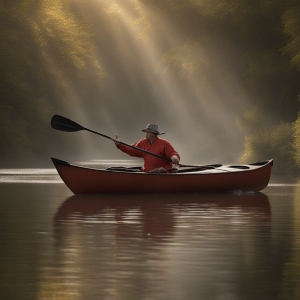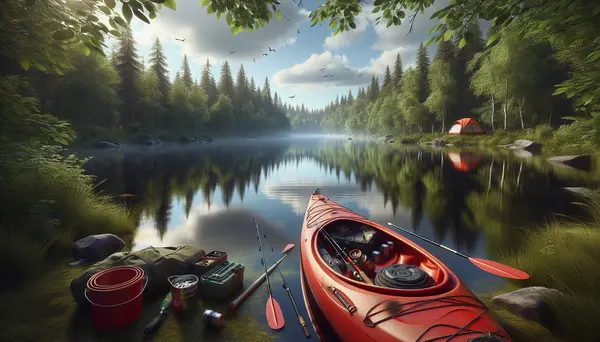Table of Contents:
If you're looking to combine the serenity of kayaking with the thrill of fishing, then kayak fishing might just be the perfect outdoor pursuit for you. As a hybrid of two immensely popular outdoor sports, kayak fishing offers the opportunity to explore diverse waterways and enjoy close encounters with a variety of fish species, all while reaping the benefits of physical exercise. Ideal for both beginners and experienced anglers, this unique angling approach enriches your fishing experiences by ushering in an element of adventure and tranquility.
Introduction to Kayak Fishing
So, what exactly is kayak fishing? Essentially, it's angling from a kayak. Sounds simple, right? While it may sound straightforward, there are several key elements to consider and learn before you dip your paddles and throw your line in the water.
Kayak fishing incorporates the best of both worlds - the excitement of catching fish and the calmness and mobility that a kayak allows. The stealthy approach provided by kayaks often guarantees a successful catch, as the minimal water disturbance leads to a less frightful fish, ready to bite your bait.
One of the significant advantages of kayak fishing is its low-entry cost. Unlike a motorboat, kayaks are more affordable and easier to transport, opening up the world of fishing to many who previously found it inaccessible. Additionally, kayaking is an environmentally friendly way to fish, causing little to no water pollution and allowing for a silent approach to fish inhabited areas.
Critical to its appeal, kayak fishing allows access to waters that would be difficult or impossible for larger fishing vessels to reach. As a paddler, you're free to explore secluded bays, river rapids, and shallow lake inlets, making it a fantastic choice for those who enjoy the thrill of discovery and want an extra layer of challenge in their angling method.
Why Kayak Fishing?
Perhaps you're wondering, why take up kayak fishing when traditional angling methods have worked for years? First of all, the direct engagement with the water and marine life that kayak fishing allows is unparalleled. Unlike motorized boats, kayaks do not scare away fish with loud noises or vibrations. This gives you a quieter and more serene fishing experience, maximizing your opportunities for a successful catch.
Additionally, kayaks can venture where big boats cannot. The size and flexibility of a kayak make it perfect for exploring narrow creeks, shallow flats, and hard-to-reach spots teeming with fish. As a bonus, you can access these fruitful fishing grounds in near silence, enhancing your chances of coaxing that prize-worthy fish onto your hook.
Kayak fishing also brings a dash of excitement and adventure that standard fishing methods can't offer. With every paddle, you're exploring uncharted territory; with every cast, you're potentially reeling in a catch of a lifetime. Plus, maneuvering your kayak to battle a fighting fish combines physical exercise with an adrenaline rush. Now, isn't that a thrilling prospect?
Finally, let's not forget the environment. In our world increasingly plagued by pollution and climate change, kayak fishing serves as an eco-friendly alternative to motorized fishing boats. So, as you soak up the tranquility of the waters and wait for a bite on your line, you can take pride in doing your part for Mother Nature too.
Choosing the Right Fishing Kayak
When it comes to kayak fishing, ensuring you have the correct setup is crucial for a successful day out on the water. The perfect kayak for you will largely depend on the type of fishing you plan to do and where you'll be fishing.
The first thing to consider is the type of kayak. There are two main types: sit-on-top and sit-inside kayaks. Sit-on-top kayaks are more popular for fishing because they have more storage space and are easier to get in and out of. Sit-inside kayaks are more streamlined and can be better for longer trips or in colder water, but they often lack the storage space needed for fishing gear.
Next, think about the water conditions you'll be fishing in. If you're going to be out on calm lakes or slow rivers, a wider, smaller kayak will work well. But for faster waters, large waves or off-shore fishing, you'll want a longer, narrower kayak for stability.
Another consideration is how much gear you plan to bring with you. Will you need space for live bait, a cooler, fishing tackle? Make sure your kayak has enough storage for all your fishing necessities.
Finally, consider your budget. While higher-end kayaks offer more features, don't forget that even a basic kayak can get you out on the water and catching fish.
Use these points as a guide, but at the end of the day, the best fishing kayak is the one you feel comfortable and confident in.
Pros and Cons of Kayak Fishing
| Pros | Cons |
|---|---|
| Kayak fishing can be cost-effective | Can be physically demanding |
| Allows access to hard-to-reach fishing spots | Takes time to learn and master |
| Offers a full-body workout | Could be potentially dangerous |
| Enables a serene natural experience | Weather conditions can greatly affect experience |
| Reduces carbon footprint and fish disturbance | Less storage space for equipment |
Essential Kayak Fishing Gear

Just like any other form of fishing, kayak fishing necessitates the use of specific gear to ensure not only a great fishing experience but also your safety. Here’s a rundown of the must-have kayak fishing equipment:
Fishing Rod and Reel: This seems obvious, right? Yet, you need to think about the kind of rod and reel that is suitable for kayak fishing. Shorter rods are recommended as they make maneuverability easier.
Kayak Paddle: A good lightweight paddle can change your fishing experience significantly. It's worth investing in one that's light in your hands and in the water.
Kayak Seat: A comfortable seat is key for those long hours on the water. Ensure your kayak seat provides good back support.
Life Jacket: Safety should always be on top of your priority list. Wearing a life jacket, regardless of your swimming abilities, is a must?
Kayak Anchor: This tool lets your kayak stay in one area, especially where the current or wind can drift you away from your prime fishing spot.
Fish Finder: This cool gadget helps locate fish underwater and can be crucial for those serious about making big catches.
Tackle box: A well-organized tackle box saves time and keeps your hooks, baits, pliers, and other necessities within easy reach.
While this is not an exhaustive list, these essentials will ensure you're well-equipped for your kayak fishing adventure. Remember, being well-prepared translates to more fishing time and increases your chances of landing a great catch.
Safety Tips for Kayak Fishing
With excitement often comes a bit of danger. Like any water-related activity, kayak fishing involves certain risks. But with those risks come various ways to ensure safety. Here are key safety tips to keep in mind:
Firstly, always wear a lifejacket. No matter how confident of a swimmer you might be, accidents can happen, and a lifejacket is a basic safety tool that can be a lifesaver in an emergency.
Next, check the weather before you head out. Weather conditions can change rapidly, especially on larger bodies of water. It's crucial to be aware of the forecast and to prepare accordingly.
Thirdly, take a buddy with you whenever possible. If something goes wrong, having another person there can make all the difference. Plus, it can make the trip more enjoyable!
Also, pack safety gear. This could include a whistle to signal for help, a first aid kit for any minor injuries, and a rope for emergencies.
Finally, remember that waters can be unpredictable. It's important to understand and respect the body of water you're fishing on. Be cautious of currents, tides, and underwater obstacles.
By following these tips and putting safety first, you can ensure that your kayak fishing adventure is not only fun and exciting, but also safe.
Techniques and Tips for Kayak Fishing

Kayak fishing, like any sport, requires technique and practice. Here are some tips to get you started. First, know your gear. Familiarize yourself not only with your fishing rods and bait, but also with your kayak. Understand how it moves, how it turns, and how it handles the wind and the waves.
Next, learn to cast with one hand. You'll often need one hand to paddle and steer while you cast with the other. This skill will take practice, but soon it will become second nature.
Use your anchors. Most fishing kayaks come with anchors, which can help you stay in the prime fishing spot without fighting the current or wind. Just drop the anchor, set your line, and wait for a bite.
Always stay vigilant. The water is a dynamically changing environment. Always be aware of your surroundings, including changes in the weather, water conditions, and the presence of other boats.
Lastly, always remember - safety comes first. Always wear a lifejacket, inform someone of your fishing plan and estimated time of return, and carry a whistle or other signaling device in case of emergency.
These are just the basics. The more you fish from your kayak, the more tricks and tactics you'll pick up.
Conclusion: Why Kayak Fishing is Worth It
If you're a fan of both watersports and fishing, the thrill of kayak fishing is hard to beat. Imagine gliding silently across the water, exploring unchartered sections of rivers or lakes, with the possibility of snagging your favorite fish at every cast. Now, that's an adventure right there!
Beyond the excitement and thrill it brings, kayak fishing is also a rewarding sport on so many levels. It fosters an ongoing connection with nature, helps improve your physical health, and who could forget the mouth-watering satisfaction of grilling a fresh catch for the day?
Yes, it might require a bit of learning and getting used to, but the experiences it offers are genuinely worth it. So why not give kayak fishing a shot? Trust us; you'll be hooked in no time!
Essential FAQs for Kayak Fishing Enthusiasts

What equipment do I need for kayak fishing?
The essential equipment for kayak fishing includes a fishing kayak, paddle, PFD (Personal Flotation Device), fishing gear (rods, lines, baits), anchor, and safety equipment (such as a whistle, headlamp, and first aid kit).
Is kayak fishing safe?
Kayak fishing is generally safe if you follow safety guidelines such as wearing a PFD, being aware of weather and water conditions, understanding how to self-rescue, and carrying communication devices.
How do I choose the right kayak for fishing?
The right kayak for fishing depends on factors like your budget, fishing style, preferred fishing locations, and comfort. Consider the kayak's stability, storage space, seating, and weight capacity.
What type of fish can I catch when kayak fishing?
The type of fish you can catch when kayak fishing typically depends on your location. However, common types include bass, trout, pike, and saltwater species like redfish and tarpon.
Do I need a special license for kayak fishing?
Depending on your location, you may need a fishing license. The rules can change when moving from freshwater to saltwater fishing, so always check local regulations.







